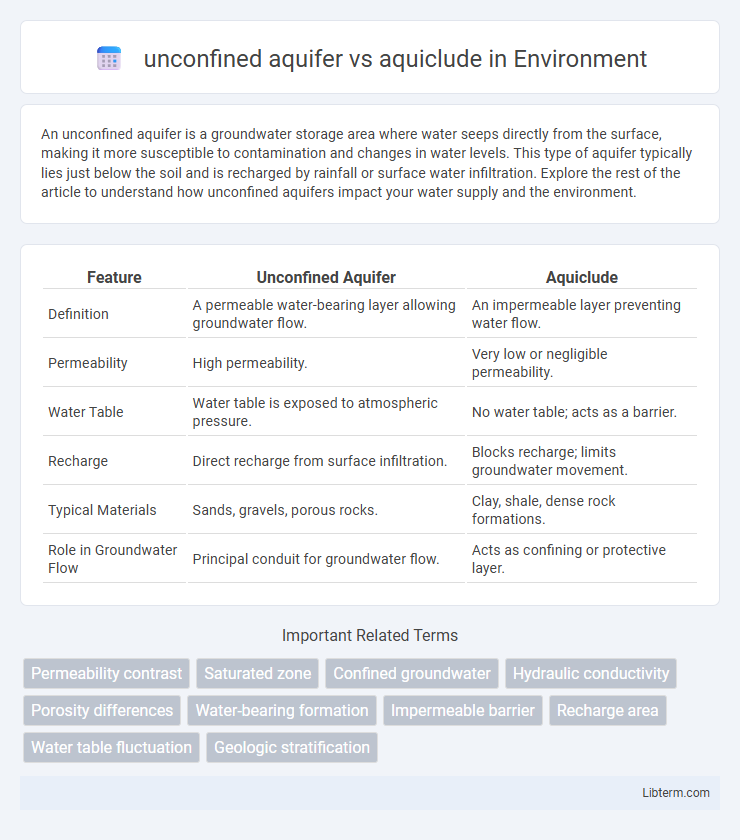An unconfined aquifer is a groundwater storage area where water seeps directly from the surface, making it more susceptible to contamination and changes in water levels. This type of aquifer typically lies just below the soil and is recharged by rainfall or surface water infiltration. Explore the rest of the article to understand how unconfined aquifers impact your water supply and the environment.
Table of Comparison
| Feature | Unconfined Aquifer | Aquiclude |
|---|---|---|
| Definition | A permeable water-bearing layer allowing groundwater flow. | An impermeable layer preventing water flow. |
| Permeability | High permeability. | Very low or negligible permeability. |
| Water Table | Water table is exposed to atmospheric pressure. | No water table; acts as a barrier. |
| Recharge | Direct recharge from surface infiltration. | Blocks recharge; limits groundwater movement. |
| Typical Materials | Sands, gravels, porous rocks. | Clay, shale, dense rock formations. |
| Role in Groundwater Flow | Principal conduit for groundwater flow. | Acts as confining or protective layer. |
Introduction to Unconfined Aquifers and Aquicludes
Unconfined aquifers are groundwater reservoirs where water is stored in permeable materials, such as sand or gravel, with their upper boundary defined by the water table, allowing direct recharge from surface water. Aquicludes, in contrast, are impermeable or significantly low-permeability geological formations like clay or shale that prevent water movement and act as barriers to groundwater flow. Understanding the hydraulic properties and spatial distribution of unconfined aquifers and aquicludes is crucial for effective groundwater management and contamination risk assessment.
Defining Unconfined Aquifers
Unconfined aquifers are groundwater reservoirs where the water table is exposed to the atmosphere through permeable soils, allowing direct recharge from surface water. These aquifers are characterized by their lack of an overlying impermeable layer, distinguishing them from aquicludes, which are impermeable geological formations that prevent water flow. The porosity and permeability of unconfined aquifers enable water movement and storage, crucial for sustainable groundwater extraction and recharge studies.
Understanding Aquicludes
Aquicludes are geological formations composed of impermeable materials such as clay or dense rock that prevent water movement, unlike unconfined aquifers which allow water to flow freely through porous sediments like sand or gravel. Understanding aquicludes is crucial for groundwater management because they act as barriers, confining water within adjacent aquifers and influencing the direction and rate of groundwater flow. Identifying aquicludes helps in predicting aquifer recharge areas and protecting water quality by limiting contaminant migration between water-bearing layers.
Key Differences Between Unconfined Aquifers and Aquicludes
Unconfined aquifers are groundwater reservoirs with a permeable upper boundary allowing direct infiltration from the surface, enabling water recharge through soil and porous material. Aquicludes are impermeable geological formations that restrict water flow, acting as barriers to groundwater movement due to their extremely low permeability. The key differences lie in their ability to transmit water--unconfined aquifers support active water storage and flow, while aquicludes inhibit groundwater exchange and prevent recharge.
Geological Formation of Unconfined Aquifers
Unconfined aquifers form in permeable geological formations such as sand, gravel, or fractured rock that allow water to easily infiltrate from the surface, resulting in a water table that varies with recharge and discharge. Unlike confined aquifers, unconfined aquifers lack an overlying impermeable layer, making their upper boundary the water table itself. The geological characteristics of these formations influence groundwater flow, recharge rates, and the susceptibility to contamination.
Properties and Composition of Aquicludes
Aquicludes consist of impermeable or nearly impermeable materials such as clay or dense shale that prevent water flow, differing from unconfined aquifers which contain permeable sediments like sand and gravel allowing water movement. The low permeability of aquicludes results from tightly packed particles and fine-grained composition, effectively blocking groundwater transmission. These properties make aquicludes essential as confining layers that isolate aquifers and control subsurface water dynamics.
Water Movement and Storage in Unconfined Aquifers
Unconfined aquifers allow water to move freely through permeable materials like sand and gravel, enabling rapid recharge and discharge cycles due to their direct connection to the surface. These aquifers store significant volumes of groundwater in pore spaces and transmit water efficiently, supporting wells and sustaining ecosystems. In contrast, an aquiclude is a geological formation with extremely low permeability that acts as a barrier to water flow, preventing both movement and significant storage of groundwater.
Role of Aquicludes in Groundwater Flow
Aquicludes play a critical role in groundwater flow by acting as impermeable barriers that prevent water movement between aquifers, thus confining and directing groundwater flow within unconfined or confined aquifers. These geological formations, composed of dense clay or rock, create distinct hydraulic boundaries essential for maintaining pressure and water storage in adjacent permeable layers. Their presence influences groundwater recharge patterns, flow velocities, and the overall sustainability of water resources in hydrogeological systems.
Practical Applications and Implications
Unconfined aquifers provide readily accessible groundwater for agricultural irrigation, municipal water supplies, and industrial use, making them vital for sustainable water resource management. Aquicludes act as natural barriers preventing water flow, which influence the design of wells and the containment of contaminants in hydrogeological engineering projects. Understanding the interactions between unconfined aquifers and aquicludes is essential for effective groundwater recharge strategies and contamination risk assessments.
Summary and Conclusion
An unconfined aquifer is a groundwater reservoir bounded by permeable material above and a water table surface, allowing direct recharge from precipitation. In contrast, an aquiclude is a geological formation with extremely low permeability that effectively restricts water flow and prevents significant groundwater movement. Understanding the distinct hydraulic properties of unconfined aquifers and aquicludes is crucial for effective groundwater management and contamination risk assessment.
unconfined aquifer Infographic

 libterm.com
libterm.com